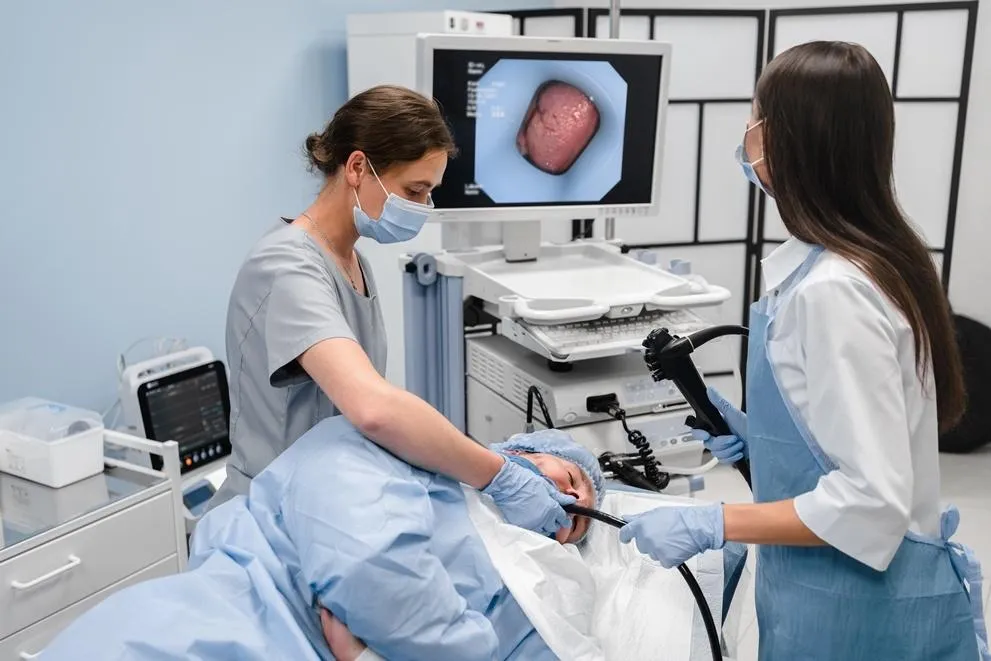
What Is Gastroscopy? And Why Is It Needed?
A gastroscopy involves threading a small tube with a camera down your food pipe (oesophagus) and into your stomach to look for any abnormalities. Common reasons for a gastroscopy include acid reflux, difficulty swallowing, and stomach pain. The procedure is a little uncomfortable but otherwise safe.
Otherwise known as an “endoscopy,” the procedure allows your doctor to see problems within your body without making an incision. The camera is threaded via your mouth. If necessary, the doctor will take small biopsies during the procedure for later analysis.
What Is a Gastroscopy?
Gastroscopy is a diagnostic medical procedure where a doctor or nurse views your stomach using an endoscope (a thin tube with a camera and light on the end). This device is about as thick as your little finger.
Numbing gel is often used at the back of the throat to make the procedure more comfortable. You can also be sedated if you wish. The camera is inserted through the mouth, into the oesophagus, and down to the stomach and sometimes the duodenum (the first part of the intestines).
The procedure allows the doctor to spot and record any abnormalities in the food pipe, stomach, and duodenum for later analysis. The doctor may also take a biopsy if they find an area that looks abnormal. The procedure is sometimes known as an “upper GI endoscopy” or “OGD.”
Why You Might Need a Gastroscopy
Your doctor may suggest a gastroscopy if there are signs that something isn’t quite right in your oesophagus, stomach, or upper small intestine. It’s often used to investigate ongoing problems such as:
Frequent heartburn or acid reflux
Difficulty or discomfort when swallowing
Ongoing upper tummy pain
Unexplained sickness or vomiting
Losing weight without trying
Possible internal bleeding (for example, vomiting blood or passing black stools)
Indigestion that isn’t improving with treatment
A gastroscopy can also be used to keep an eye on pre-existing conditions like Barrett’s oesophagus, stomach ulcers, or coeliac disease. It gives your doctor a clear view of what’s going on inside and helps them decide the best way to treat it.
What Happens During a Gastroscopy?
Gastroscopy is almost always an outpatient procedure. That means you arrive that day, undergo the procedure, and then head home. It’s advised that you organise a ride home, especially if you choose to be sedated, as the sedative means you cannot drive safely.
The doctor or nurse will ask you to lie on your side. A plastic mouth guard is placed between your teeth to prevent you from biting the endoscope. It is then threaded into your mouth and down into the stomach. It can be a little uncomfortable at first.
Your doctor will visualise your oesophagus, stomach, and duodenum via a monitor. Air is passed into the stomach to make it easier to see. This can cause bloating and belching — don’t be embarrassed; this is completely normal.
If the doctor identifies anything unusual, they’ll take a painless biopsy. It’ll be sent to a lab for testing. This doesn’t mean anything is wrong.
Preparing for a Gastroscopy
You will receive instructions from the hospital or outpatient department before your procedure. The typical preparations are:
Avoid eating or drinking for 4-6 hours before the procedure
Stop certain medications before the procedure
Ask someone you trust to accompany you home if you have the sedative
Once the procedure is completed, you cannot drink alcohol or operate machinery for 24 hours due to the sedative. Always wait for the effects to wear off. If you only have the anaesthetic throat spray (numbing spray), you can carry on as normal.
Complications of a Gastroscopy
A gastroscopy is a safe procedure. Tens of thousands of patients undergo a gastroscopy annually without any complications. However, like any medical intervention, it carries some risks.
The most common complications include:
Abdominal pain. If it worsens or becomes severe, seek medical attention
Fever. A raised temperature can indicate infection.
Difficulty breathing
Vomiting blood
In extreme cases, you can develop a chest infection or pneumonia. However, most people just feel a little tired and have a sore throat for a few days afterwards.
Get to the Root of Your Heartburn Causes
A gastroscopy is a common first-line investigation for prolonged heartburn and gastroesophageal reflux disease. It can identify the underlying causes behind your symptoms, especially if they haven’t improved with medications like proton pump inhibitors.
Don’t struggle with acid reflux — we can help you diagnose the problem.
If you’re struggling with ongoing reflux or indigestion, finding the exact trigger can make all the difference. The Functional Gut Clinic offers specialist testing to get to the root of common heartburn causes and other digestive symptoms, so you can move beyond guesswork and start a treatment plan that works.

